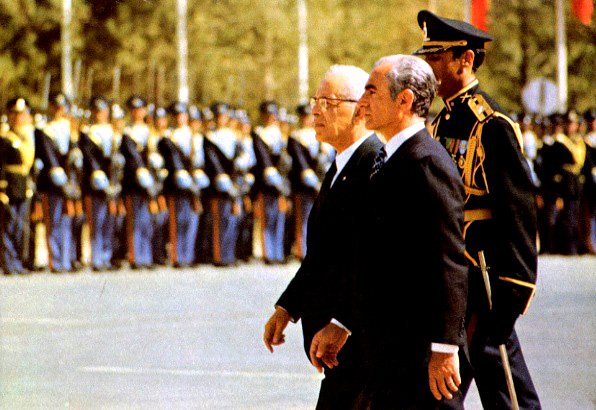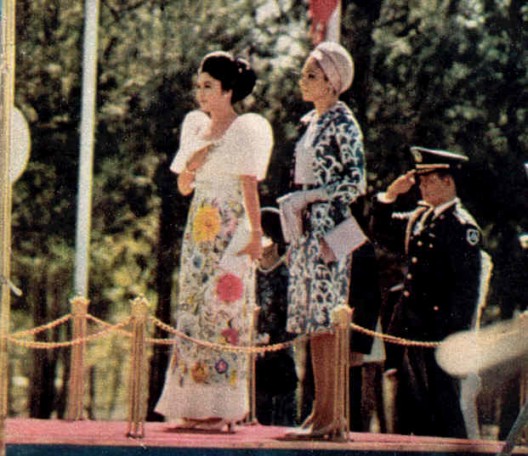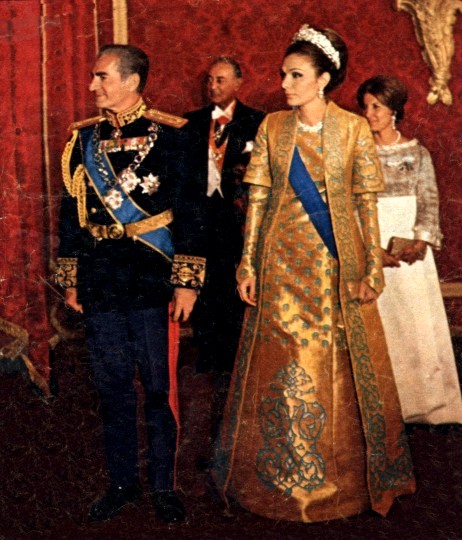




During the afternoon of the 12th and until the afternoon of the 14th October, dozens of guests from all over the World arrived from Teheran to Shiraz airport. To receive the heads of state, the Shah and the Shahbanou would usually travel from the Tent City in Persepolis to Shiraz and take part in all the military honours, which became nearly constant given the amount of prominent guests. The Shah and Shahbanou would usually welcome the heads of state who arrives accompanied by their wives, the Shah alone would receive those who came alone, the Shahbanou alone would receive wives that came alone and other members of the Imperial Family or the Prime Minister would receive other guests. The guests were then taken through the 50 km of highway to Persepolis, a highway lightened by two thousand giant oil-fuelled beacons, set 100 metres away from each other and powered by the National Iranian Oil Company (NIOC).
Arriving at the Tent City in Persepolis, heavily secured by hundreds of policemen and guardsmen, the guests would undoubtedly be dazzled by what they could see. The display of luxury and good taste was unbeatable, always mingling the comfort with the sublime Persian traditions. Taking the opportunity to revive an almost lost art, traditional Iranian tapestries depicting the portraits of the guests were woven by old artisans and hung in the living rooms of the respective tents. On their arrival, the guests had a mini bar waiting for them: a bottle whisky Chivas, one of champagne Möet Chandon, one of vodka, six bottlers of beer, a number of those of water, soda and juice. Pure luxury and good taste to receive people who were used to the very best.


The mood was undoubtedly one of grand gala, but also a relaxed one. Persepolis was prepared in a way that the guests would be able to enjoy and amuse themselves, in between the very grand and impressively unique official events. Royalty and statesmen from the five continents did seem to have enjoyed the celebrations and the possibility to live in a totally unique and sublime world during a pair of days. Members of royal families would visit each other in their tents during the evenings, to have a drink or simply a family gathering. Heads of state would meet to speak in a relaxed mood about the most important world affairs. But, most importantly, they undoubtedly would leave Persepolis with the best impression of the Empire of Iran and that was the most important goal of His Imperial Majesty.
The first grand event gathering all the state guests took place on the evening of Thursday, the 14th October 1971, on what was also the 33rd birthday of Her Imperial Majesty The Shahbanou of Iran. It was the state banquet, perhaps the grandest ever to take place and difficultly to ever be repeated, for several reasons, the first of which the fact that it is extremely hard to gather around 60 members of World royalty and heads of state from the five continents at the same table, literally.

The grandeur of the evening is almost indescribable: the Banqueting Hall was decorated with yards of blue velvet with gold embroidery, forming several canopies above the main table. To allow everyone to seat in the main table, a Baroque-inspired 57-metre-long table was built, in form of a serpent. In this dramatically unusual way (which allowed many possible protocol problems to be avoided), everyone seating there would be able to look to the whole room without much effort, while everyone in the room and the cameramen would be able to get pictures of all the members of royalty and statesmen that they would like to. Serving as a major item of decoration of the Banqueting Hall was the symbol of the Persian Empire, the peacock, which could be seen represented in various places of the room.
Above the canopy in the middle of the table was the Pahlavi coat of arms. The Shah would take his place in the curve to the left of the centre, while the Shahbanou would take her place in the opposite curve, to the right of the centre of the long and impressive table. The main table and the others for the rest of the nearly 600 guests were lavishly decorated in blue and gold, while from the pink silk ceiling hung dozens of magnificent Bohemian chandeliers, each with dozens of lamps.


In the Tent of Honour, in which the guests presented the compliments to Their Imperial Majesties before proceeding to the Banqueting Hall (and where the Imperial Family had taken residence during the celebrations), the decoration was of impressive red damask woven in Italy and embroidered in gold. Worth of any palace of Europe, the Tent of Honour looked more like a splendorous Throne Room, where the guests, with their majestic titles loudly announced, came to present to their compliments to the King of Kings, the successor of Cyrus the Great. Meanwhile, Mozart and Schubert sounded, played by an orchestra from a minstrel’s gallery, while the ladies deeply curtsied to the Shah and the Shahbanou, wearing their most glittering gala dresses, their best jewels and their highest decorations. For men the dress code could be uniform, but the vast majority chose white tie and decorations. The heads of state and members of royal families placed themselves to the left of the imperial couple in the Tent of Honour, after presenting their compliments and received compliments from thoaw who followed, while the other guests entered directly to the Banquetting Hall.
At the end of the compliments, the Shah, in his impressive uniform of Commander of the Armed forces and wearing the collar and ribbon of the Nishan-i-Pahlavi, the Order of Pahlavi, led Her Majesty the Queen of Denmark to the Banqueting Hall. The Shahbanou, wearing a fantastic gold-woven dress embroidered in silver (designed, woven and cut by Iranian women, like all the dresses she wore during the celebrations) and the blue sash of the Nishan-i-Aryamehr, the Order of the Light of the Aryans, was led by His Imperial Majesty The Emperor of Ethiopia and they were followed by members of European royalty and others heads of state, like Their Majesties the King and Queen of the Hellenes.
